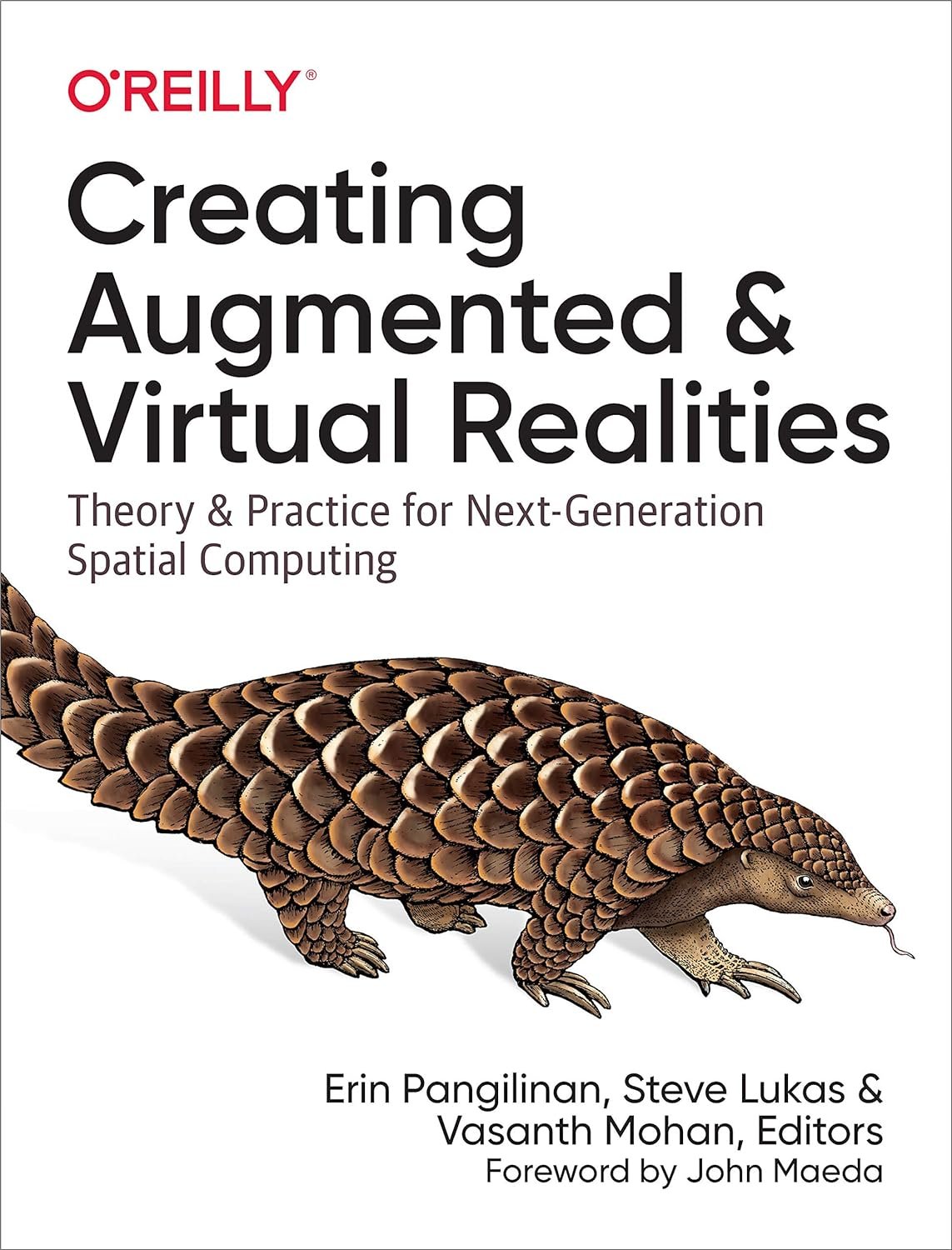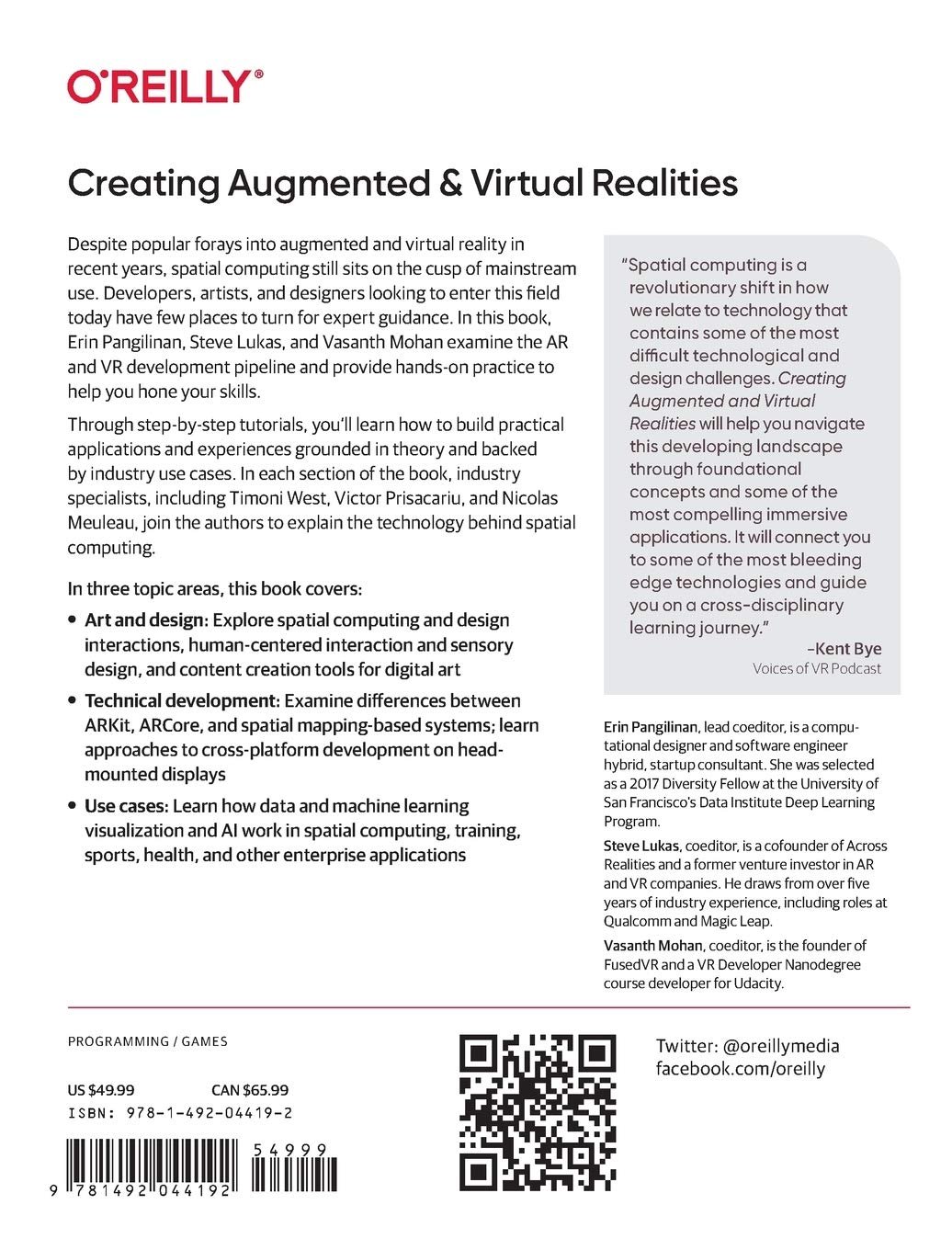Description
Editorial Reviews
About the Author
Erin Pangilinan is lead co-editor of Creating Augmented and Virtual Realities. She works as a computational designer and software engineer hybrid and startup consultant. She was selected as a 2017 Diversity Fellow at the University of San Francisco’s Data Institute Deep Learning Program.
Steve Lukas has been exploring the landscape of spatial computing in various roles from software design to venture capital & development relations with companies such as Qualcomm Ventures and Magic Leap. As a co-founder of Across Realities, he focused on advancing the XR industry by enabling shared digital realities spanning all platforms.
Vasanth Mohan, Founder, FusedVR, VR Developer Nanodegree Course Developer
Important information
To report an issue with this product or seller, click here.



Igor –
Know what you’re getting
Shirley –
As someone who’s immersed in the latest news about the field, this book didn’t really provide much value. However, I do think that it’s a great middle-tier read for people who are familiar with the field, but don’t know much. It also has a few typos.
Heather Allen –
I’m a geek girl at heart who has always dreamed of a reality portrayed in our favorite science fiction novels of the past. As I have only recently in the last few years been able to dig deep into AR / VR & Mixed Reality space and follow along with it, I will say that I really loved reading this book. It covers a large amount of ground that took me forever to dig out and research on my own. I think that the book is a wonderful beginning and intermediate overview of the varied products, history, technologies and items that have helped create this growing space in this growing corner of the tech industry landscape.The fun thing is, that no one really knows what will happen just yet as what we are using is still working itself out and evolving from year to year. It’s been an eye opening read for me to see what I have already missed out on, as I thought I was watching grow from afar. I instead wished that we had something like this years ago as there is just so many different areas to focus on now.This giant space that covers so many different technologies that are not related to each other until you add in the mixed reality name. For me, How do you prepare for this evolving area that builds on top of multiple different unrelated areas in tech? In the past, I was tossing back and forth if I wanted to jump in and focus completely on this space. If I could have read this book back then, then I would have gone all in instead of waiting for now.
A. Hamilton –
I have long been interested in learning about Augmented and Virtual Reality. This anthology is not a “how to code a specific VR game”; This book has contributions from a wide range of authors, covers breadth within the spatial computing world. Several chapters include a history lesson of the specific technology to help provide context for the reader. I found it interesting that several authors also mentioned the changing technology for spatial computing meant that their references may be “outdated” in a couple of years as the technology changed by leaps and bounds. My favorite section of the book was Part 4 : Creating cross-platform augmented reality and virtual reality written by Steve Lukas, which gave a clear practical reasoning why learning & developing cross-platform now will help future proof work as technology evolves. I also appreciated the different use cases presented in the book that show the range beyond just VR games. I will continue to dip into the book as I continue to learn about the space.
Amazon Customer –
As a newbie in the XR development scene, this book was a great resource in understanding the context and community around the industry, as well as the industry’s current and future challenges. Additionally, there were a number of real XR stories along with some implementation details that are pretty motivating and could help in getting you to start your first project.I think the most valuable parts of this book are the references and links to further details, which are helpful in a world where filtering and finding good information is difficult.Thanks to the authors!
Claude Heintz –
This anthology of essays is especially useful to providing an overview of the current state of virtual reality and augmented reality technology. It is not a textbook, or how-to-code-an-app with ARKit type of book. Instead it collects a set of essays that provide different perspectives on the current state of the field. It looks forward to a time when VR/AR is part of the standard UX much as the mouse is today. For developers wanting an executive summary of the state of the field in 2019, this book could be for you.
Ann –
I really liked how this book places everything that is going on now in context. I loved reading the history of how we came to be where we are – this is a really good jumping-off point for anyone interested in getting a strong overview on AR/VR – there are also interesting chapters on ML/AI – I would recommend this book to anyone who would like to quickly grasp a broad overview of creating AR/VR.
K. S. Mader –
The book was a very interesting deep dive into a number of aspects of AR/VR and provided both technical and design context for the current uses and challenges going forward. The chapters on visualization and machine learning were particularly exciting. On a more practical side, the use cases chapters and Sports XR provide insight into where the technology is heading.